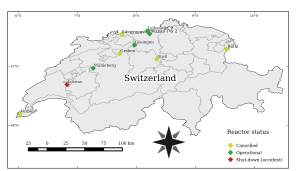
Summary
Switzerland adopted commercial nuclear power in 1969 and has a total of five operational nuclear reactors. These are located in four plants that supply 36.4% of Switzerland’s energy. While reactor construction halted in the 1980s due to pressure from a growing anti-nuclear movement (reinvigorated by the Chernobyl disaster), existing plants have been strongly criticized for their age (the Beznau 1 reactor is the oldest in the world), risk of accident, and lack of long-term waste disposal plans. At the time of the adoption of nuclear-energy, the technology was actually favoured by environmental groups over hydroelectricity and fossil fuels. This initial approval soon turned to opposition through non-violent direct action, supported by a range of political parties, NGOs, activist networks and associations.
The Swiss anti-nuclear movement experienced early success during the occupation of the Kaiseraugst nuclear power plant construction site in 1975. Around 500 activists drew a 15 000-strong crowd of supporters on-site and widespread popular support in the Basel region and nationally, leading to construction plans being cancelled. However, popular support and momentum for the movement has fluctuated since then, with short-term waves of mobilization largely catalysed by outside events, specifically the Chernobyl and Fukushima Daiichi disasters. The current outlook paints a picture of mixed success. Switzerland’s post-Fukushima pledge to exit nuclear energy is upheld in principle, but watered down in practice through periodic extensions of the operating licences of existing plants.
Click here for the factsheet (4 pages): FS_050_Anti-Nuclear Movement Switzerland



